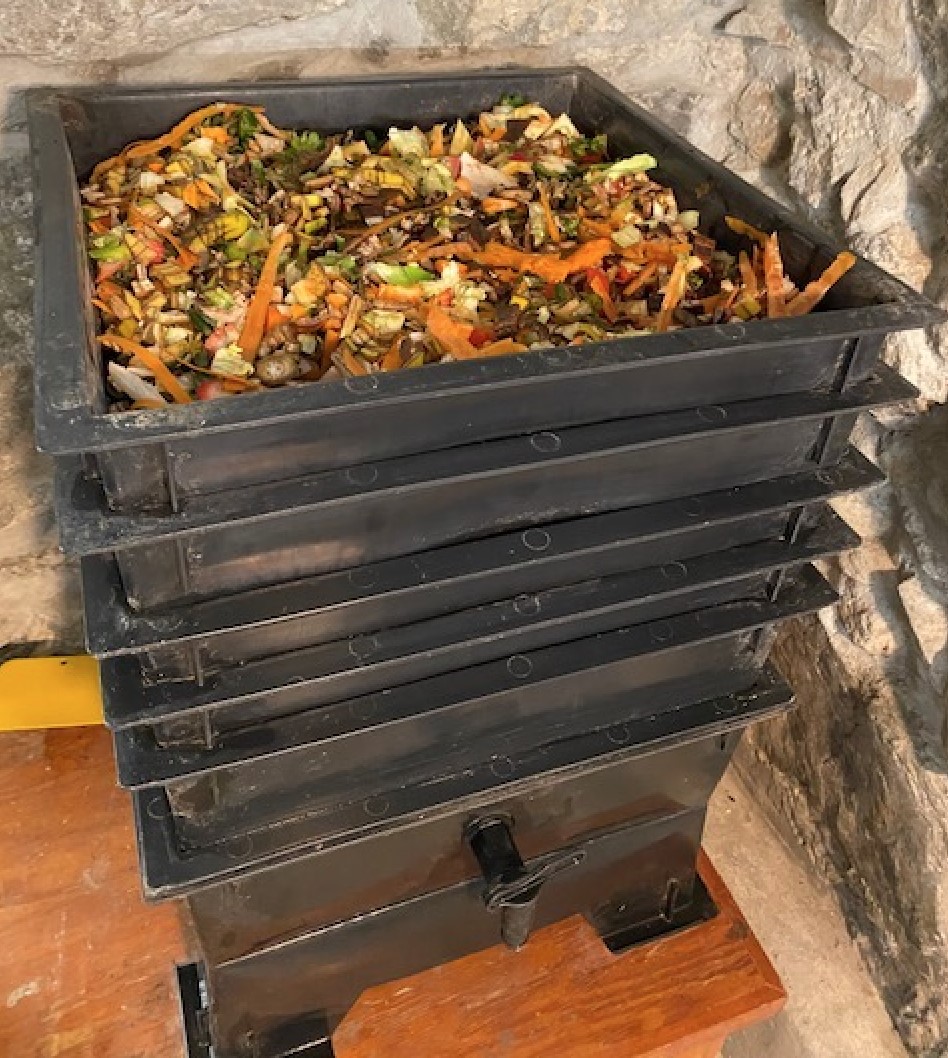This piece is part of the Old South Church Climate Change Task Force's series, "Climate: The Small Things Matter"
OUR IN-HOME COMPOSTING EXPERIENCE
About 12 years ago, Joel’s office started using an in-office composting bin system, The Worm Factory®, to convert some of their food scraps into compost rather than throwing them in the trash or down the garbage disposal. It was such an easy-to-use, odor-free system that we decided to set one up in our home and have been using it ever since.
WHAT IS WORM COMPOSTING?
“Worm composting is using worms to recycle food scraps and other organic material into a valuable soil amendment called vermicompost, or worm compost.”
Although this write-up focuses on how our system works, there are other options to consider. In addition to composting at home there are also pickup services available should you prefer that approach instead. For us, we prefer composting at home because:
- It was a one-time cost
- It enables us to get rid of the bulk of the type of food scraps we generate on our own schedule while also getting the benefit of organic material for our garden
- It really is kind of fun and interesting to be so directly involved in the composting process
The ‘Resources’ section at the end has a few links to help you get started in exploring if composting is right for you.
SUPPLIES
Worm Bin
The Worm Factory® comes with multiple stackable, mesh-bottom trays. To start, food scraps and bedding are placed in the lower tray. Once the tray fills up with composted matter, another stackable tray is placed on top of it and food scraps and bedding are added to it. Because of the mesh bottom, the worms can migrate up to the food in the next tray without any work from us.
The bin should be kept in a cool, dry place. We keep ours on a table in our basement.
Composting Worms
Red Wigglers are the recommended worms to use for composting. Once ours arrived in the mail, we added them to the bin and have not needed to order more since our initial purchase.
Food Scraps
Food scraps can include fruits, vegetables and coffee grounds. We don’t include starches, but most sites say they can be used sparingly. Foods to avoid are meat, poultry, fish, bones, dairy, oils and fats.
When we generate appropriate food scraps, we chop them up and keep them in a container in our refrigerator until feeding day.
Shredded Paper
The key to the paper bedding is that it be soft and light in order to provide a good environment for the process to work. We use shredded newspaper but shredded cardboard or other non-plastic paper could be used instead.
Instructions for setting up the initial bedding will be specific to the system you choose.
FEEDING SCHEDULE
Having an ongoing food scrap container in our refrigerator allows us to feed the worms about once every 7 - 10 days. The worms could be fed more frequently than that.
We add the food scraps and shredded paper to the top tray, cover it all with a piece of newspaper, put the cover lid back on top and we’re done, almost. There is the ‘worm tea’ to retrieve too.
The Worm Factory® has a spigot on its bottom level. Using a recycled spaghetti sauce bottle, we collect the liquid via the spigot and then pour it on the soil around our outdoor plants.
[[{"fid":"4104","view_mode":"wysiwyg","fields":{"alt":"Worm factory bin, food scraps added, shredded paper added, and worm tea","height":525,"width":1577,"style":"width: 100%; height: 100%;","class":"media-element file-default","data-delta":"5","format":"wysiwyg","alignment":"","field_file_image_alt_text[und][0][value]":"Worm factory bin, food scraps added, shredded paper added, and worm tea","field_file_image_title_text[und][0][value]":false,"external_url":""},"link_text":null,"type":"media","field_deltas":{"5":{"alt":"Worm factory bin, food scraps added, shredded paper added, and worm tea","height":525,"width":1577,"style":"width: 100%; height: 100%;","class":"media-element file-default","data-delta":"5","format":"wysiwyg","alignment":"","field_file_image_alt_text[und][0][value]":"Worm factory bin, food scraps added, shredded paper added, and worm tea","field_file_image_title_text[und][0][value]":false,"external_url":""}},"attributes":{"alt":"Worm factory bin, food scraps added, shredded paper added, and worm tea","height":525,"width":1577,"style":"width: 100%; height: 100%;","class":"media-element file-wysiwyg","data-delta":"5"}}]]
HARVESTING THE COMPOST
Depending on the system you use, when and how to harvest the compost will vary. For us, it is usually once every few months. Signs that it is ready are that the compost is nearly black and in small chunks. We just remove the bottom tray, dump the compost in our garden and then rinse the tray out with a hose. The tray is now ready to add to the top of the stack when we need it.
RESOURCES
Once you start searching on vermiculture and worm composting, you will find many sites, articles, and even education plans. Below are some links to help get you started.
- Vermicomposting For Beginners
- Vermi-Composting HowTo
- 7 Best Worm Composters – Top Compost Bin For Red Worm 2020
- FindWorms.com - lists supplier of worms by zip code
Compost Pickup Services
- There are also some options for using a compost pickup service instead. One website with links to services by state is: https://compostnow.org/compost-services/








